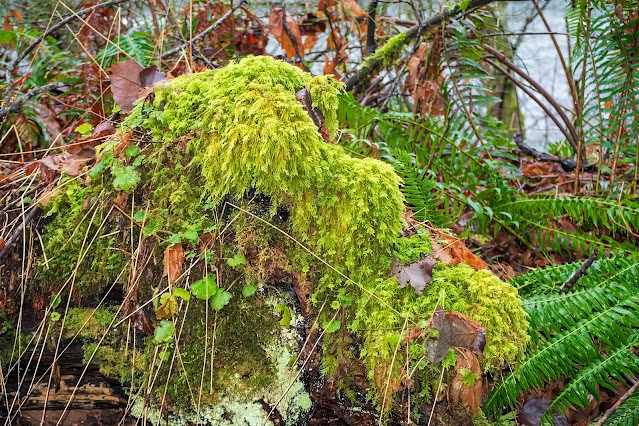The weather people said it wasn't going to rain all day. I went out early, just in case, and had to turn on my windshield wipers almost right away. The clouds seemed lighter off to the north; I took that highway. At Roberts Lake, the trees were still dripping, but the rain had stopped.
I reminded myself, starting down the trail, that I was going to look at the whole forest, the trees and the moss and the lake, and not be distracted by mushrooms. It has been all mushrooms, almost all the time, for too long.
It was cold and dark down there under the trees with no sunlight attempting to filter through, but the air felt clean, scented by dying needles and wet bark. (It's a pity that there's no way to transmit scents over the web; you'll just have to imagine it.) The only sounds were my footsteps and the occasional plop as another branch shook off its load of rainwater.
 |
| Ferns and trunks and moss. The bluish sky beyond the trees is over the lake. |
 |
| Mist over the hills. |
 |
| Sleeping lake. No birds, not even a lonely loon. |
But oh, yes, there were mushrooms, insisting on being noticed.
 |
| Step moss and lichens and little white mushrooms. |
The draped tan flags are the ghosts of vanilla leaves. They hang there, all through the forest, not crumbling, holding fast to their slender stems, waving nonchalantly in the breeze and the pouring rain, until the snow covers them and forces them down to the ground.
 |
| For comparison; here are vanilla leaf plants, in the spring. |
Los meteorológicos dijeron que no iba a llover hoy. Salí temprano, por si las moscas, y tuve que prender el limpiaparabrisas dentro de unos pocos minutos. Las nubes hacia el norte parecían estar menos densas, y escogí la carretera correspondiente. Cuando llegué al lago Roberts, ya no llovía, pero seguían cayendo gotitas desde la copa de los árboles.
Había decidido tratar de observar todo el bosque; los árboles, los musgos, el lago y lo demás, y no dejarme distraer con hongos; por un tiempo todo ha sido hongos, hongos, hongos. Bellos, pero ¿qué se me había escapado?
Bajo los árboles en este dia de finales de noviembre, hacía frio y había poca luz. El aire se sentía limpio, y llevaba aromas de agujas de abeto moribundas y de corteza de árbol húmeda. (Lástima que no hay manera de transmitir las aromas por el internet; pues tendrás que imaginártelas.) Oía solamente el sonido de mis pasos y de vez en cuando un "plop" de una gota haciendo impacto sobre los helechos.
1. Helechos, troncos, musgos. Donde se ve el cielo tras los árboles es que el espacio se abre sobre el lago.
2. Neblina cubriendo los cerros.
Saliendo de las sombras del bosque, llegué a la orilla del lago. Los colores se veían atenuados; verde oscuro, gris frio, café apagado; nubes espesas escondían la luz del sol. El único color con algo de calor, y eso apenas visible, se debía a las candelillas de los alisos rojos.
3. El lago parece dormir. No se ve ningún pájaro, ni siquiera un colimbo solitario.
Pero sí había hongos, e insistían en ser observados; saltaban a la vista.
4. Musgo de escalera, líquenes, y honguitos blancos. Lo que parece ser trapitos colgantes son las fantasmas de hoja de vainilla, Achlys triphylla. Se mantienen allí como banderitas esparcidas por todo el bosque sobre sus tallos delicados, sin desmoronarse, sin soltarse, agitándose cuando la lluvia cae con fuerza, meciéndose con las brisas suaves, hasta que por fin la nieve las cubre y las aplasta contra el suelo.
































